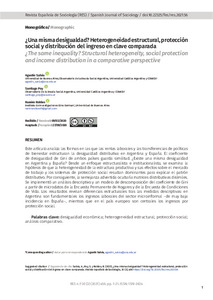Por favor, use este identificador para citar o enlazar este ítem:
https://repositorio.uca.edu.ar/handle/123456789/13977| Título: | ¿Una misma desigualdad? : Heterogeneidad estructural, protección social y distribución del ingreso en clave comparada ¿The same inequality? : Structural heterogeneity, social protection and income distribution in a comparative perspective |
Autor: | Salvia, Agustín Poy Piñeiro, Santiago Robles, Ramiro |
Palabras clave: | ANALISIS COMPARATIVO; DESIGUALDAD ECONOMICA; PROTECCION SOCIAL; ESTRUCTURA SOCIAL; DESIGUALDAD SOCIAL; DISTRIBUCION DE LA RIQUEZA | Fecha de publicación: | 2021 | Editorial: | Federación Española de Sociología | Cita: | Salvia, A., Poy Piñeiro, S., Robles, R. ¿Una misma desigualdad? : Heterogeneidad estructural, protección social y distribución del ingreso en clave comparada [en línea]. Revista Española de Sociología. 2021, 30 (3). doi: https://doi.org/10.22325/fes/res.2021.56. Disponible en: | Resumen: | Resumen:
Este artículo analiza las formas en las que las rentas laborales y las transferencias de políticas
de bienestar estructuran la desigualdad distributiva en Argentina y España. El coeficiente
de desigualdad de Gini de ambos países guarda similitud. ¿Existe una misma desigualdad
en Argentina y España? Desde un enfoque estructuralista e institucionalista, se examina la
hipótesis de que la heterogeneidad de la estructura productiva y sus efectos sobre el mercado
de trabajo y los sistemas de protección social resultan dominantes para explicar el patrón
distributivo. Por consiguiente, la semejanza advertida ocultaría matrices distributivas disímiles.
Se implementó un análisis descriptivo y un modelo de descomposición del coeficiente de Gini
a partir de microdatos de la Encuesta Permanente de Hogares y de la Encuesta de Condiciones
de Vida. Los resultados revelan diferencias estructurales tras las medidas descriptivas: en
Argentina son fundamentales los ingresos laborales del sector microinformal –de muy baja
incidencia en España–, mientras que en el país europeo son centrales los ingresos por
protección social. Abstract: The article analyzes how labor market income and social benefits shape the household income distribution in Argentina and Spain. The Gini coefficient in both countries is quite similar. Does it exist the same inequality in both countries? From a structuralist and institutionalist theoretical approach, this article examines the hypothesis that the structural heterogeneity and its effects both in the labor market and in the social protection systems, is critical to explain income inequality. Thus, the similarities in inequality indexes hide structural differences in income distribution matrices. The paper follows a quantitative design based on the microdata of the Permanent Household Survey (Argentina) and the Survey of Income and Living Conditions (Spain). Both descriptive analysis and a decomposition model of the Gini coefficient were implemented. The results reveal structural differences underlying descriptive measures: in Argentina labor incomes from a microinformal sector is crucial –which has little importance in Spain–, whereas, in Spain, incomes from social protection system are more important in the distributive matrix. |
Cobertura Espacial: | Argentina España |
URI: | https://repositorio.uca.edu.ar/handle/123456789/13977 | ISSN: | 1578-2824 | Disciplina: | SOCIOLOGIA | DOI: | 10.22325/fes/res.2021.56 | Derechos: | Atribución-NoComercial-CompartirIgual 4.0 Internacional | Fuente: | Revista Española de Sociología Vol. 30, No.3, 2021 |
| Aparece en las colecciones: | Colaboraciones en ediciones externas |
Ficheros en este ítem:
| Fichero | Descripción | Tamaño | Formato | |
|---|---|---|---|---|
| misma-desigualdad-heterogeneidad.pdf | 386,16 kB | Adobe PDF |  Visualizar/Abrir |
Visualizaciones de página(s)
99
comprobado en 27-abr-2024
Descarga(s)
67
comprobado en 27-abr-2024
Google ScholarTM
Ver en Google Scholar
Altmetric
Altmetric
Este ítem está sujeto a una Licencia Creative Commons

